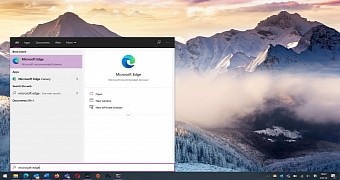Microsoft has recently released Windows 10 version 20H2, or October 2020 Update, to the first wave of devices, with the company now promising to make the new update available to more computers over the coming weeks.
Needless to say, Windows 10 October 2020 Update isn’t a massive update and many actually described it as a little bit more than a service pack. In other words, the focus has been on under-the-hood improvements rather than on new features, so theoretically, the October update should guarantee a smoother experience with Windows 10 from one end to another.
But what change that many might not even notice concerns the browser.
Earlier this year, Microsoft launched the all-new Microsoft Edge browser based on the Chromium engine, the same one that powers Google Chrome and a series of other browsers. The new Edge became the new default browser in Windows 10, thus replacing the legacy version on all devices.
What this means is that Microsoft Edge legacy becomes a second-class citizen of the operating system, obviously with the goal of getting the ax rather sooner than later.
Windows 10 October 2020 Update comes with the Chromium-powered version of Microsoft Edge enabled by default in the operating system, and launching the legacy sibling isn’t as easy as it was before. And that’s because searching for the original Edge version on Windows 10 no longer returns the legacy browser, thus making it a challenge to find it.
The good news is that Microsoft Edge legacy is still there, only that Microsoft has seemingly removed the known ways to launch it. And yet, you can still do it with the method we’ll describe below, even though it clearly isn’t the most convenient approach.
The first thing you need to do is to open the Registry Editor and navigate to the following path:
HKEY_LOCAL_MACHINE\SOFTWARE\WOW6432Node\Microsoft\EdgeUpdate\ClientState\{56EB18F8-B008-4CBD-B6D2-8C97FE7E9062}
Look for a key called BrowserReplacement and delete it. Needless to say, since this method involves messing with the registry, you should create a backup before deleting the key, just to make sure that you’ll be able to restore the device in case something goes wrong.
At this point, you should be able to launch Microsoft Edge legacy using the Edge result in the search box, only that the aforementioned workaround needs to be used every time the Chromium browser gets an update. And this is because new updates configure the application as the default once again, thus overwriting your changes.
On the other hand, you can also create a desktop shortcut to launch the legacy version of Edge much easier after you make the aforementioned registry changes.
The target of this shortcut should be the following:
%windir%\explorer.exe shell:Appsfolder\Microsoft.MicrosoftEdge_8wekyb3d8bbwe!MicrosoftEdge
And now, the big question: why would anyone use the legacy version of Microsoft Edge these days since it no longer gets any new features?
For many, this is required for compatibility and testing purposes. Furthermore, others believe that legacy Edge is still better than its Chromium successor in some regards, including as far as the battery life is concerned, so they just don’t want the browser to go for the time being.
As far as Microsoft is concerned, everyone should just make the switch to the Chromium browser, as this is the only way to get the latest improvements and updates.
The new Edge is available not only on Windows 10, but also on Windows 7, Windows 8, Windows 8.1, and macOS. A Linux Dev build has also been released recently, with the stable version planned for the next few months.

 14 DAY TRIAL //
14 DAY TRIAL //